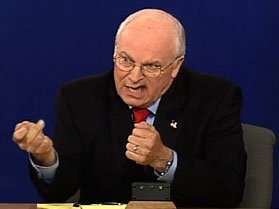If you've been reading DWT at all, you already know what I think of the Inside-the-Beltway universe and how fond I am (NOT) of political consultants. But I always make an exception for Jim Carville. My company once hired him-- before we were swallowed by a big right-wing corporation called AOL-- to make a speech at one of our annual conventions. He was great and before he spoke I got to spend some time with him. I've been an admirer ever since.
Today he and Democratic pollster Stan Greenberg issued an extensive survey of the electorate for Democracy Corps, "THE CHANGE ELECTORATE ON THE EVE OF MORE CHANGE, A report on the shattered standing of the Republicans ." It's an incredibly heartening document that goes way beyond BushCo's sinking poll ratings. I think it's worth reading if you take electoral politics seriously. So, here it is:
Even before the announcement of any criminal indictments at the heart of the Bush White House, Republicans and the president himself were already facing their own shattered standing with the country. We send this memo as an important benchmark, as events perhaps worsen for the Republicans. About 60 percent of the country has settled into dark conclusions about the direction of the country, the economy, and the war. On all measures, they have hit their low point. That the Democrats have a 9-point lead in the congressional contest overall – and nearly as great a lead when we ask using the actual names of incumbent members – is actually the least interesting measure of these times.
Most interesting is the collapse of confidence in the Republicans on some critical attributes related to public service – on being trustworthy and in-touch, having the right priorities and new ideas, on caring for people and putting the public interest first. On many of these key measures of public support, not even 40 percent believe they apply to the Republicans.
The other interesting development, before the new phase in the White House, is the new signs of life among the Democrats. As you know, we have been quite critical of the Democrats for not being more expressive about their beliefs and plans and bold enough in their thinking, but this poll shows some reduced negativity about the Democrats and some greater respect on change, new ideas, putting the public interest first, and being for families. While Democrats remain at 48 percent in this poll-– as in virtually every poll since the beginning of the year-– they are poised to make gains over the Republicans, who have fallen below 40 percent of the vote.
The emerging images of the party are setting up the 2006 election as a big choice – with the Democrats for change and cleaning house in Washington, electing people who will put the American people first and work for everyone, not just the few.
Deepening Demand for Change
There is no measure where we do not find a rising demand for change, reflecting a deepening discontent with the economy, Iraq, the direction of the country, the Bush administration and the Congress.
• By 65 to 32 percent, voters say the economy is off on the wrong track – rising significantly this month. Over half the country strongly believes the economy is off on the wrong track.
• By 59 to 37 percent, voters say the Iraq war was not worth the cost in lives and dollars – the highest level since we began asking the question. By 56 to 41 percent, voters think the war has made us less, not more secure – matching the worst moments of the war.
• The public has lost confidence in how the Bush administration ensures the country’s security: by 55 to 39 percent, voters now say America’s security depends more on our ties with other countries than on our military strength-– again, the high point on the desire for a new approach.
• We are approaching 60 percent of the voters who want to go in a “significantly different direction” than Bush, with only 37 percent wanting to continue his direction for the country-– the low point in confidence. It is even worse for Congress, with 64 percent wanting that kind of change.
As a result, the pull back and disengagement from Bush continues. There are few loyalists left. Only 24 percent of voters now give Bush a “strong” approval rating, continuing downward to its lowest point-– 12 points below where it was at the election.
While the Democrats have only a 5-point lead with independents, these voters are almost as intent on change as partisan Democrats: two thirds want to go in a significantly different direction than Bush and almost three-quarters want to go in a significantly different direction than the current Congress.
The Changing Character of the Republican Party
The changes we are witnessing are not just falling indicators, like stock prices, that have ups and downs. The Republicans have lost hold of some fundamental things that will not be easily recouped. There is a broken bond here that leaves the party in a very different place.
Looking at the party on its own, just 38 percent describe the Republican Party now as “trustworthy” and “in touch;” 39 percent say they have “new ideas for addressing the country’s problems” and 40 percent say they have “the right priorities.” Critically, each of these has crashed 12 points from March, with the exception of priorities, which dropped 9 points. The muted excitement about the new administration clear in its direction and willing to take on tough issues has given way to judgments about an untrustworthy lot who are out of touch, with bad ideas and misplaced priorities. Only 42 percent say the Republicans are “on your side” (down 6 points). The voters reaffirm their judgment from earlier in the year that Republicans are part of the Washington mess (58 percent) and devoted to big corporate interests, not the middle class (68 percent).
The Democrats have emerged with huge advantages over the Republicans on a broad range of values and attributes – produced first by a pull back from the Republicans but also by not insignificant gains for the Democrats on some key measures. As we see below, the Republicans biggest declines in comparison with the Democrats have come on reform and change, cares about people, new ideas and thinking about the future, convictions, improving America and putting the public interest first. Barely 30 percent opt for the Republicans on advancing the public interest, trust, reform and change, for the middle class or for new ideas. Those are all well below the Republicans’ current vote for Congress.
Democratic Gains
It is important to underscore that important Democratic gains have come on putting the public interest first, knowing what they stand for, reform and change, and cares about people and families. In the comparison of the parties, the percent choosing the Democrat on each of these went up about 5 points from January. That is an important sign of progress, though we should note that on the majority of attribute comparisons, the percentage choosing the Democrats went up only two points or less.
Democrats looked at on their own (not in comparison to the Republicans) fare better with the voters now. In the aftermath of the presidential election, they were particularly weakened on clarity of beliefs and ideas and on values. Today, Democrats have improved 14 points on new ideas, which is a little surprising, though likely artificially suppressed last February. More typical of the best results are the 7 or 8 point gains on putting the public interest first, being for families, change, on your side and sharing your values.
Democrats have not made noticeable gains on thinking long term, standing up to the special interests, knowing what they stand for, or being trusted to keep America safe. These are not insignificant areas and they are relevant to the judgment people will make in November.
The Changed Partisan Landscape
In the end, 2006 will be a zero sum game, with the Republican crash reflected in the choice people make. The 9-point Democratic lead in the generic contest is reflected in even bigger advantages on the big themes, values and convictions that structure the choice in the election.
The biggest Democratic advantages all relate to putting people and the public interest ahead of the big special interests. The Democrats enjoy advantages of 25 points or more on standing up for people (not big special interests), being for the middle class and caring about people, and standing up for the public’s interests. On this terrain, almost 58 percent say these terms describe the Democrats, but barely 30 percent opt for the Republicans. The Democratic margin is three times the Democrats’ advantage in the actual race for Congress. That is why one of the strongest definitions of the election focuses on making the country work for everyone, not just the few.
The Democrats at this point enjoy an 18-point advantage on “reform and change” – reflecting the simple conclusion, for many that they may be the change. Their advantage is double their vote margin for Congress, re-enforcing the determination of Democrats to turn 2006 into a change election.
On a whole series of other comparisons, Democrats are doing respectably well, though mostly reflecting their vote margin. This includes being on your side, improving America, and new ideas. Here, the Democrats are chosen by less than half the electorate, helping explain why Democrats keep bumping up against the 48-percent ceiling. Raising the Democrats as a party battling for people and advancing new ideas to improve the country promises a yet stronger vote.
The Democrats’ margin on trust and shares your values, thinking long term, and creating prosperity are only modest and below their vote. Shares your values is the most important one of these to shift upwards, given the regression modeling. Right now, the Democrats have a 5-point advantage, half their congressional margin, and are chosen by just 46 percent of the voters.
The two strongest areas for the Republicans are “security and keeping the country safe” and “know what they stand for.” Their 15-point advantage here is what keeps Republicans in the game, though for now, these are not driving the congressional vote. In any case, the Republican margin has been cut in half since January on this key choice for the election.
First Clues of 1994
Despite the Democrats’ gains relative to the Republicans on key attributes and values, the party’s overall image has barely moved upward. In this survey, the negative assessments have dropped a few points, allowing the Democrats to emerge with a marginally positive image (39 percent warm and 35 percent cool). But with declining positives (39 percent warm) and hardening negatives (41 percent cool over the last four months), the Republicans have emerged with a net negative image. That is allowing the Democrats to approach where the Republicans were in 1993 when they were challenging from the outside, though Democrats are not yet as strong.
It is worth remembering that both parties are at historic lows and this is a very alienated electorate, unhappy with Washington, the direction of the country and its political leaders. This is still a moment for the Democrats to emerge much more decisively as a bold change agent, ready to change Washington, ready to battle for people and advance new ideas for the country. There is evidence that the electorate is starting to pay attention.







